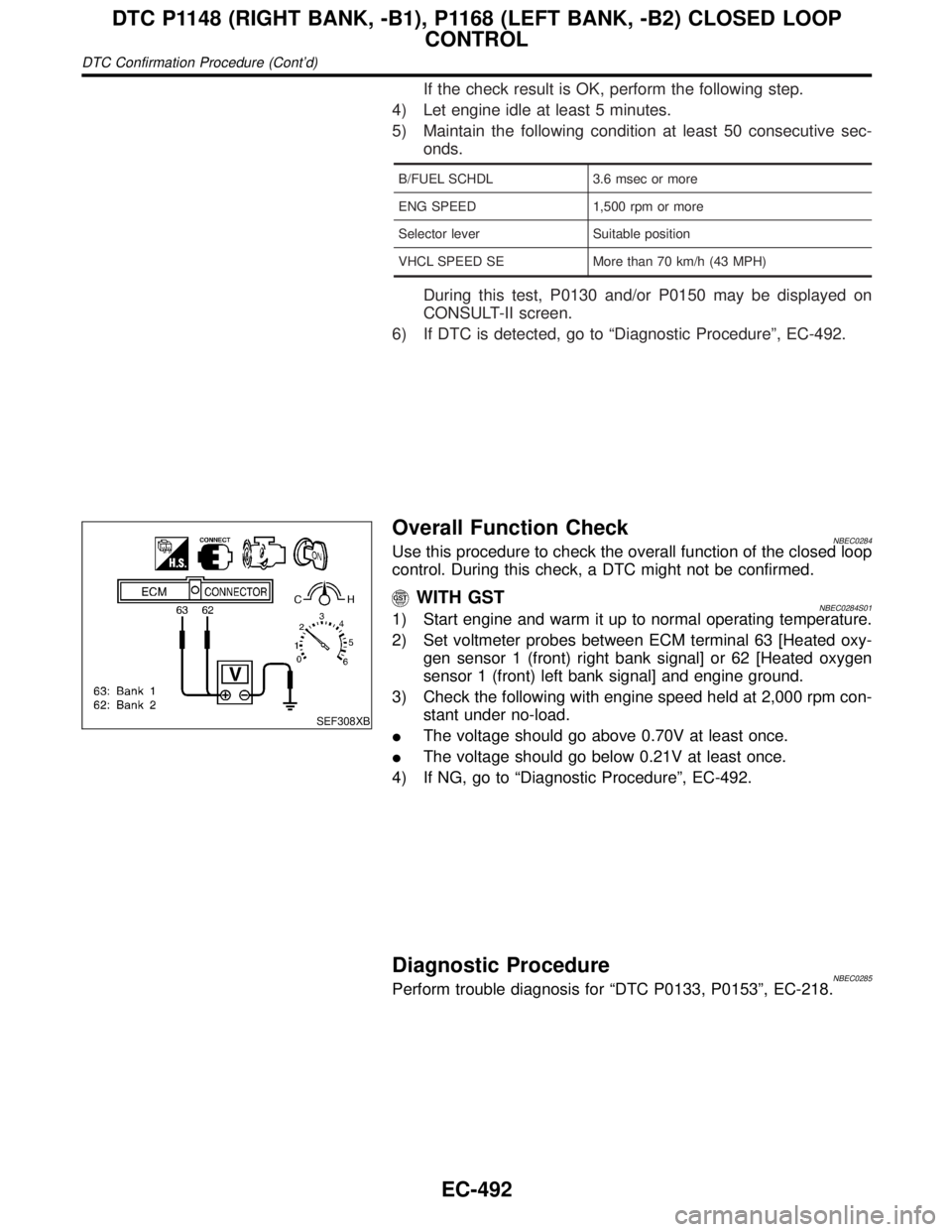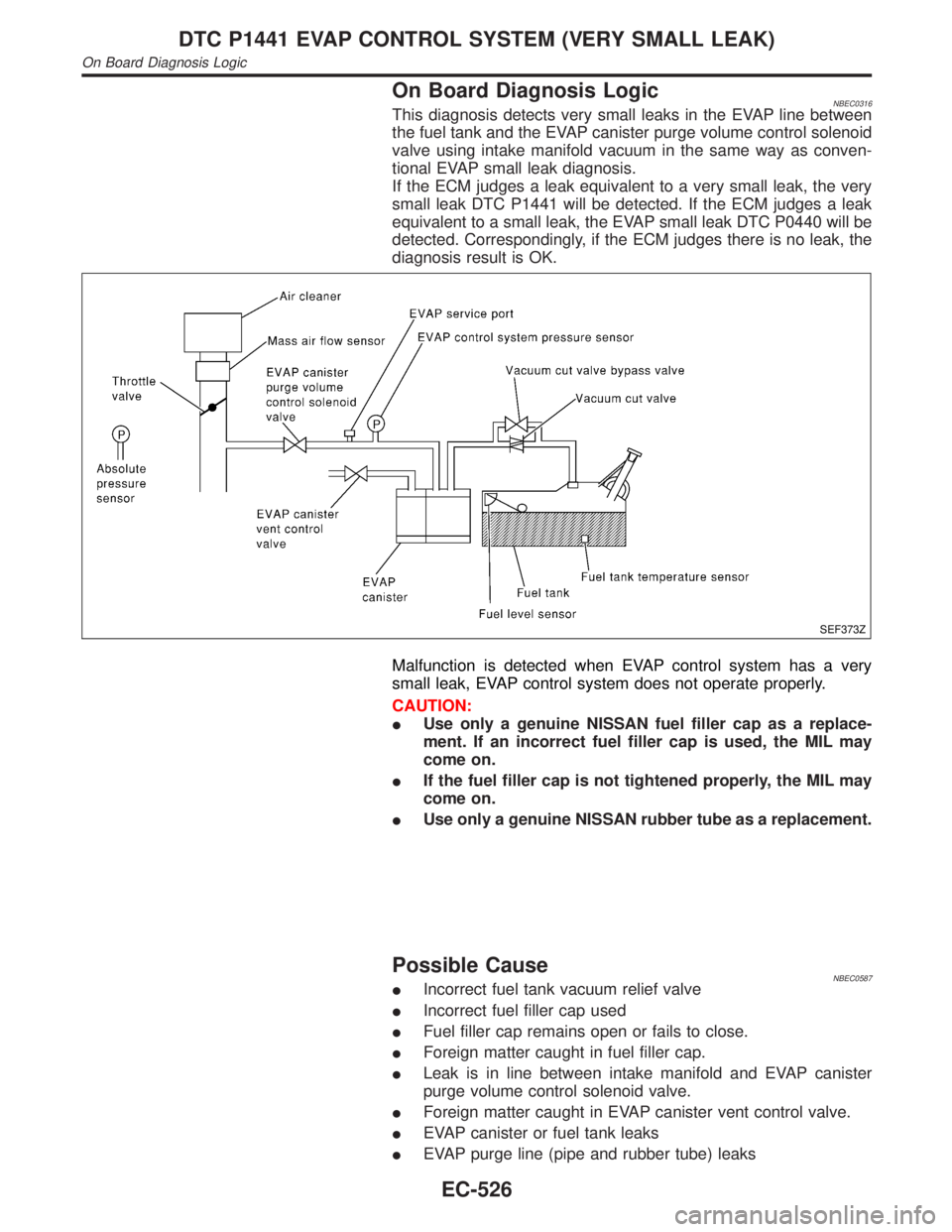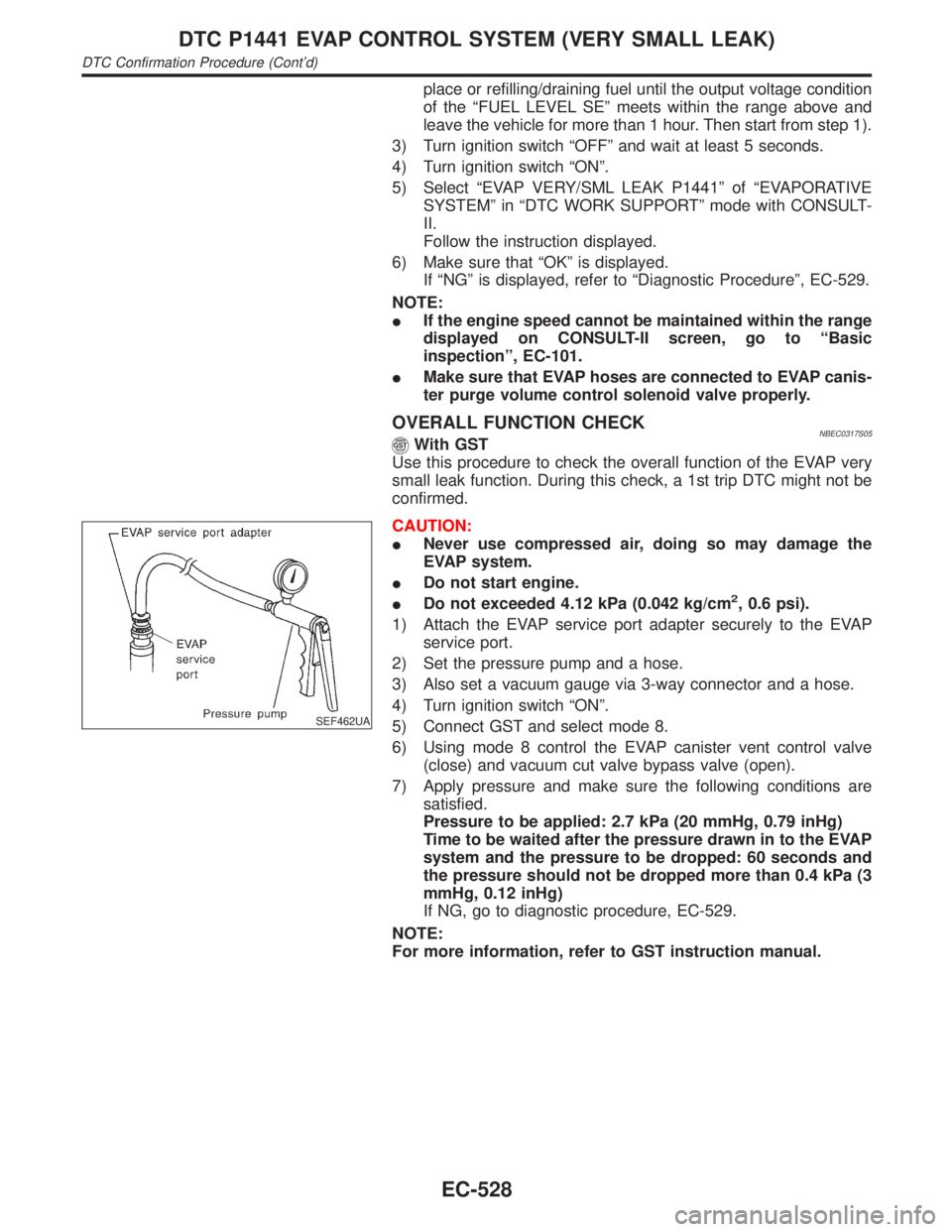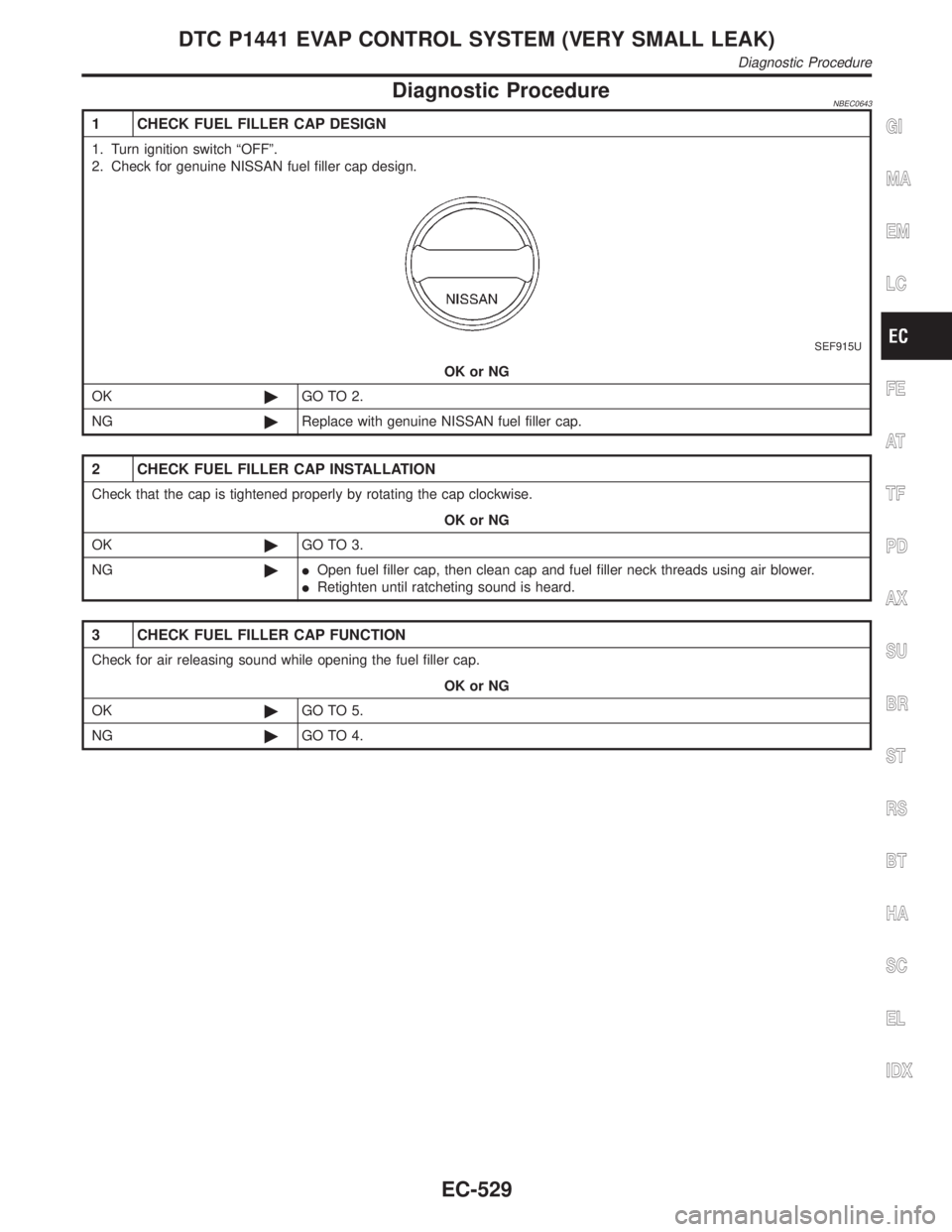2001 INFINITI QX4 Fuel
[x] Cancel search: FuelPage 951 of 2395

5 DETECT MALFUNCTIONING PART
Check the following.
IHarness connectors M2, B1
IHarness connectors M94, F27
IHarness for open between ECM and fuel level sensor
©Repair open circuit or short to power in harness on connectors.
6 CHECK FUEL LEVEL SENSOR
Refer to EL-108, ªFuel Level Sensor Unit Checkº.
OK or NG
OK©GO TO 7.
NG©Replace fuel level sensor unit.
7 CHECK INTERMITTENT INCIDENT
Refer to ªTROUBLE DIAGNOSIS FOR INTERMITTENT INCIDENTº, EC-140.
©INSPECTION END
DTC P0464 FUEL LEVEL SENSOR CIRCUIT
Diagnostic Procedure (Cont'd)
EC-416
Page 953 of 2395

Possible CauseNBEC0514IHarness or connector
(The vehicle speed sensor circuit is open or shorted.)
IVehicle speed sensor
DTC Confirmation ProcedureNBEC0245CAUTION:
Always drive vehicle at a safe speed.
NOTE:
If ªDTC Confirmation Procedureº has been previously conducted,
always turn ignition switch ªOFFº and wait at least 10 seconds
before conducting the next test.
TESTING CONDITION:
Steps 1 and 2 may be conducted with the drive wheels lifted
in the shop or by driving the vehicle. If a road test is expected
to be easier, it is unnecessary to lift the vehicle.
SEF196Y
WITH CONSULT-IINBEC0245S011) Start engine (TCS switch ªOFFº).
2) Read ªVHCL SPEED SEº in ªDATA MONITORº mode with
CONSULT-II. The vehicle speed on CONSULT-II should
exceed 10 km/h (6 MPH) when rotating wheels with suitable
gear position.
If NG, go to ªDiagnostic Procedureº, EC-421.
If OK, go to following step.
3) Select ªDATA MONITORº mode with CONSULT-II.
4) Warm engine up to normal operating temperature.
5) Maintain the following conditions for at least 10 consecutive
seconds.
ENG SPEED 1,800 - 6,000 rpm
COOLAN TEMP/S More than 70ÉC (158ÉF)
B/FUEL SCHDL 5.5 - 14.0 msec
Selector lever Suitable position
PW/ST SIGNAL OFF
6) If 1st trip DTC is detected, go to ªDiagnostic Procedureº,
EC-421.
Overall Function CheckNBEC0246Use this procedure to check the overall function of the vehicle
speed sensor circuit. During this check, a 1st trip DTC might not
be confirmed.
WITH GSTNBEC0246S011) Lift up drive wheels.
2) Start engine.
3) Read vehicle speed sensor signal in ªMODE 1º with GST.
The vehicle speed sensor on GST should be able to exceed
DTC P0500 VEHICLE SPEED SENSOR (VSS)
Possible Cause
EC-418
Page 993 of 2395

DescriptionNBEC0523If DTC P1130 is displayed with P1165, first perform trouble diag-
nosis for DTC P1165, EC-493.
SYSTEM DESCRIPTIONNBEC0523S01
Sensor Input Signal to ECMECM func-
tionActuator
Throttle position sensor Throttle position
Swirl control
valve con-
trolSwirl control valve control sole-
noid valve
"Vacuum signal
Swirl control valve actuator
"
Swirl control valve Ignition switch Start signal
Crankshaft position sensor (POS) Engine speed (POS signal)
Crankshaft position sensor (REF) Engine speed (REF signal)
Mass air flow sensor Amount of intake air
Engine coolant temperature sensor Engine coolant temperature
This system has a swirl control valve in the intake passage of each
cylinder.
While idling and during low engine speed operation, the swirl con-
trol valve closes. Thus the velocity of the air in the intake passage
increases, promoting the vaporization of the fuel and producing a
swirl in the combustion chamber.
Because of this operation, this system tends to increase the burn-
ing speed of the gas mixture, improve fuel consumption, and
increase the stability in running conditions.
Also, except when idling and during low engine speed operation,
this system opens the swirl control valve. In this condition, this
system tends to increase power by improving intake efficiency via
reduction of intake flow resistance, intake flow.
The solenoid valve controls swirl control valve's shut/open condi-
tion. This solenoid valve is operated by the ECM.
Throttle position
sensor (Idle posi-
tion)Engine speedSwirl control valve
control solenoid
valveSwirl control valve
ON Below 3,200 rpm ON Closed
OFFLess than 3,200
rpmON Closed
More than 3,600
rpmOFF Open
When engine coolant temperature is below 10ÉC (50ÉF) and above 55ÉC (131ÉF),
swirl control valve is kept open regardless of above condition.
SEF446Z
DTC P1130 SWIRL CONTROL VALVE CONTROL SOLENOID VALVE
Description
EC-458
Page 1027 of 2395

If the check result is OK, perform the following step.
4) Let engine idle at least 5 minutes.
5) Maintain the following condition at least 50 consecutive sec-
onds.
B/FUEL SCHDL 3.6 msec or more
ENG SPEED 1,500 rpm or more
Selector lever Suitable position
VHCL SPEED SE More than 70 km/h (43 MPH)
During this test, P0130 and/or P0150 may be displayed on
CONSULT-II screen.
6) If DTC is detected, go to ªDiagnostic Procedureº, EC-492.
SEF308XB
Overall Function CheckNBEC0284Use this procedure to check the overall function of the closed loop
control. During this check, a DTC might not be confirmed.
WITH GSTNBEC0284S011) Start engine and warm it up to normal operating temperature.
2) Set voltmeter probes between ECM terminal 63 [Heated oxy-
gen sensor 1 (front) right bank signal] or 62 [Heated oxygen
sensor 1 (front) left bank signal] and engine ground.
3) Check the following with engine speed held at 2,000 rpm con-
stant under no-load.
IThe voltage should go above 0.70V at least once.
IThe voltage should go below 0.21V at least once.
4) If NG, go to ªDiagnostic Procedureº, EC-492.
Diagnostic ProcedureNBEC0285Perform trouble diagnosis for ªDTC P0133, P0153º, EC-218.
DTC P1148 (RIGHT BANK, -B1), P1168 (LEFT BANK, -B2) CLOSED LOOP
CONTROL
DTC Confirmation Procedure (Cont'd)
EC-492
Page 1061 of 2395

On Board Diagnosis LogicNBEC0316This diagnosis detects very small leaks in the EVAP line between
the fuel tank and the EVAP canister purge volume control solenoid
valve using intake manifold vacuum in the same way as conven-
tional EVAP small leak diagnosis.
If the ECM judges a leak equivalent to a very small leak, the very
small leak DTC P1441 will be detected. If the ECM judges a leak
equivalent to a small leak, the EVAP small leak DTC P0440 will be
detected. Correspondingly, if the ECM judges there is no leak, the
diagnosis result is OK.
SEF373Z
Malfunction is detected when EVAP control system has a very
small leak, EVAP control system does not operate properly.
CAUTION:
IUse only a genuine NISSAN fuel filler cap as a replace-
ment. If an incorrect fuel filler cap is used, the MIL may
come on.
IIf the fuel filler cap is not tightened properly, the MIL may
come on.
IUse only a genuine NISSAN rubber tube as a replacement.
Possible CauseNBEC0587IIncorrect fuel tank vacuum relief valve
IIncorrect fuel filler cap used
IFuel filler cap remains open or fails to close.
IForeign matter caught in fuel filler cap.
ILeak is in line between intake manifold and EVAP canister
purge volume control solenoid valve.
IForeign matter caught in EVAP canister vent control valve.
IEVAP canister or fuel tank leaks
IEVAP purge line (pipe and rubber tube) leaks
DTC P1441 EVAP CONTROL SYSTEM (VERY SMALL LEAK)
On Board Diagnosis Logic
EC-526
Page 1062 of 2395

IEVAP purge line rubber tube bent.
IBlocked or bent rubber tube to EVAP control system pressure
sensor
ILoose or disconnected rubber tube
IEVAP canister vent control valve and the circuit
IEVAP canister purge volume control solenoid valve
IAbsolute pressure sensor
IFuel tank temperature sensor
IO-ring of EVAP canister vent control valve is missing or dam-
aged.
IWater separator
IEVAP canister is saturated with water.
IFuel level sensor and the circuit
IEVAP control system pressure sensor
SEF881X
SEF882X
SEF883X
DTC Confirmation ProcedureNBEC0317CAUTION:
Never remove fuel filler cap during the DTC confirmation pro-
cedure.
NOTE:
IIf DTC P1441 is displayed with P0440, perform TROUBLE
DIAGNOSIS FOR DTC P1441 first.
IIf ªDIAGNOSTIC TROUBLE CODE CONFIRMATION PRO-
CEDUREº has been previously conducted, always turn
ignition switch ªOFFº and wait at least 5 seconds before
conducting the next test.
IAfter repair, make sure that the hoses and clips are
installed properly.
TESTING CONDITION:
IOpen engine hood before conducting following proce-
dure.
IIf any of following condition is met just before the DTC
confirmation procedure, leave the vehicle for more than 1
hour.
a)Fuel filler cap is removed.
b)Refilled or drained the fuel.
c)EVAP component parts is/are removed.
IBefore performing the following procedure, confirm that
battery voltage is more than 11V at idle.
With CONSULT-II
1) Turn ignition switch ªONº and select ªDATA MONITORº mode
with CONSULT-II.
2) Make sure the following conditions are met.
FUEL LEVEL SE: 1.08 - 0.2V
COOLAN TEMP/S: 0 - 32ÉC (32 - 90ÉF)
FUEL T/TMP SE: 0 - 35ÉC (32 - 95ÉF)
INT A/TEMP SE: More than 0ÉC (32ÉF)
If NG, turn ignition switch ªOFFº and leave the vehicle in a cool
GI
MA
EM
LC
FE
AT
TF
PD
AX
SU
BR
ST
RS
BT
HA
SC
EL
IDX
DTC P1441 EVAP CONTROL SYSTEM (VERY SMALL LEAK)
Possible Cause (Cont'd)
EC-527
Page 1063 of 2395

place or refilling/draining fuel until the output voltage condition
of the ªFUEL LEVEL SEº meets within the range above and
leave the vehicle for more than 1 hour. Then start from step 1).
3) Turn ignition switch ªOFFº and wait at least 5 seconds.
4) Turn ignition switch ªONº.
5) Select ªEVAP VERY/SML LEAK P1441º of ªEVAPORATIVE
SYSTEMº in ªDTC WORK SUPPORTº mode with CONSULT-
II.
Follow the instruction displayed.
6) Make sure that ªOKº is displayed.
If ªNGº is displayed, refer to ªDiagnostic Procedureº, EC-529.
NOTE:
IIf the engine speed cannot be maintained within the range
displayed on CONSULT-II screen, go to ªBasic
inspectionº, EC-101.
IMake sure that EVAP hoses are connected to EVAP canis-
ter purge volume control solenoid valve properly.
OVERALL FUNCTION CHECKNBEC0317S05With GST
Use this procedure to check the overall function of the EVAP very
small leak function. During this check, a 1st trip DTC might not be
confirmed.
SEF462UA
CAUTION:
INever use compressed air, doing so may damage the
EVAP system.
IDo not start engine.
IDo not exceeded 4.12 kPa (0.042 kg/cm
2, 0.6 psi).
1) Attach the EVAP service port adapter securely to the EVAP
service port.
2) Set the pressure pump and a hose.
3) Also set a vacuum gauge via 3-way connector and a hose.
4) Turn ignition switch ªONº.
5) Connect GST and select mode 8.
6) Using mode 8 control the EVAP canister vent control valve
(close) and vacuum cut valve bypass valve (open).
7) Apply pressure and make sure the following conditions are
satisfied.
Pressure to be applied: 2.7 kPa (20 mmHg, 0.79 inHg)
Time to be waited after the pressure drawn in to the EVAP
system and the pressure to be dropped: 60 seconds and
the pressure should not be dropped more than 0.4 kPa (3
mmHg, 0.12 inHg)
If NG, go to diagnostic procedure, EC-529.
NOTE:
For more information, refer to GST instruction manual.
DTC P1441 EVAP CONTROL SYSTEM (VERY SMALL LEAK)
DTC Confirmation Procedure (Cont'd)
EC-528
Page 1064 of 2395

Diagnostic ProcedureNBEC0643
1 CHECK FUEL FILLER CAP DESIGN
1. Turn ignition switch ªOFFº.
2. Check for genuine NISSAN fuel filler cap design.
SEF915U
OK or NG
OK©GO TO 2.
NG©Replace with genuine NISSAN fuel filler cap.
2 CHECK FUEL FILLER CAP INSTALLATION
Check that the cap is tightened properly by rotating the cap clockwise.
OK or NG
OK©GO TO 3.
NG©IOpen fuel filler cap, then clean cap and fuel filler neck threads using air blower.
IRetighten until ratcheting sound is heard.
3 CHECK FUEL FILLER CAP FUNCTION
Check for air releasing sound while opening the fuel filler cap.
OK or NG
OK©GO TO 5.
NG©GO TO 4.
GI
MA
EM
LC
FE
AT
TF
PD
AX
SU
BR
ST
RS
BT
HA
SC
EL
IDX
DTC P1441 EVAP CONTROL SYSTEM (VERY SMALL LEAK)
Diagnostic Procedure
EC-529